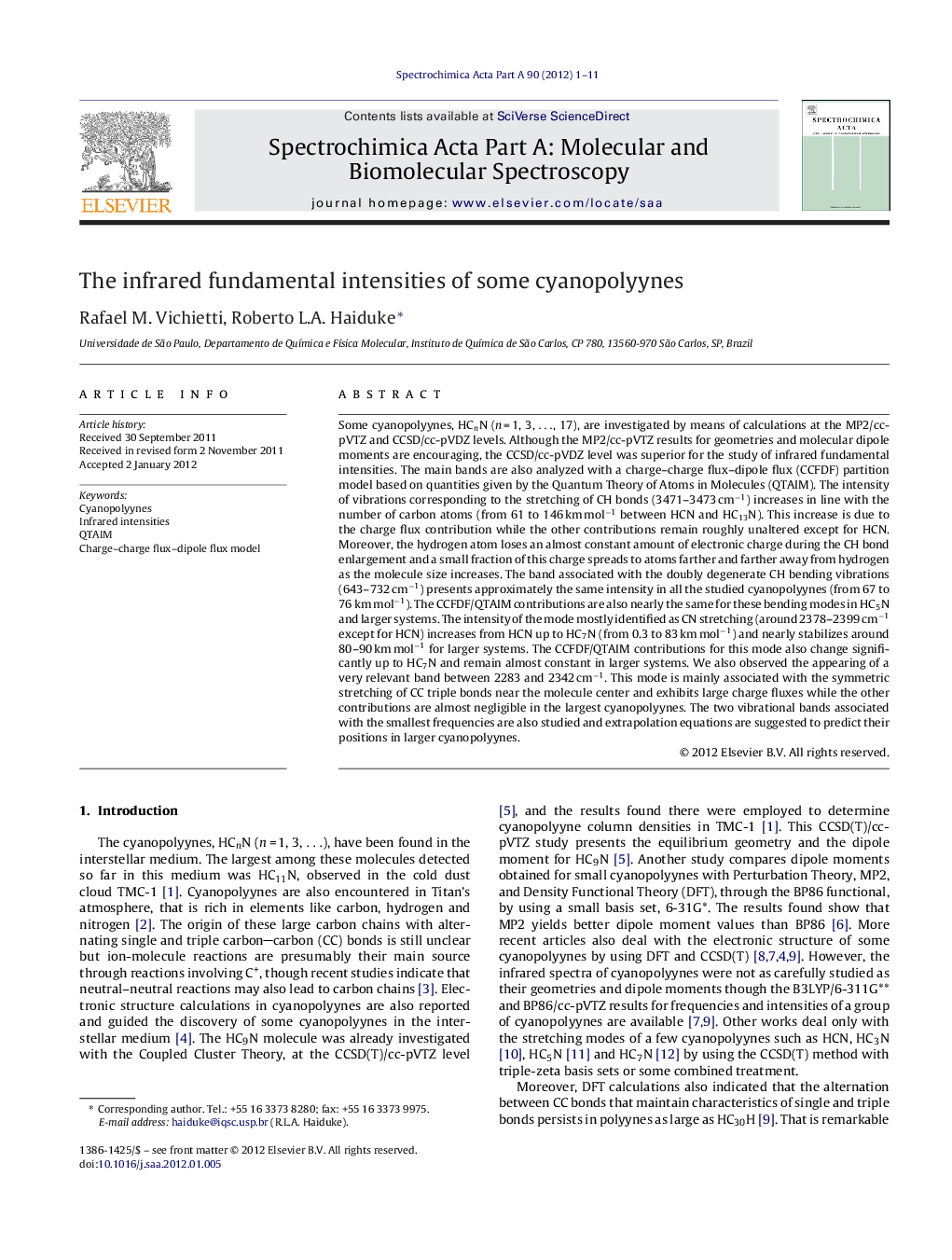| کد مقاله | کد نشریه | سال انتشار | مقاله انگلیسی | نسخه تمام متن |
|---|---|---|---|---|
| 1231983 | 1495278 | 2012 | 11 صفحه PDF | دانلود رایگان |

Some cyanopolyynes, HCnN (n = 1, 3, …, 17), are investigated by means of calculations at the MP2/cc-pVTZ and CCSD/cc-pVDZ levels. Although the MP2/cc-pVTZ results for geometries and molecular dipole moments are encouraging, the CCSD/cc-pVDZ level was superior for the study of infrared fundamental intensities. The main bands are also analyzed with a charge–charge flux–dipole flux (CCFDF) partition model based on quantities given by the Quantum Theory of Atoms in Molecules (QTAIM). The intensity of vibrations corresponding to the stretching of CH bonds (3471–3473 cm−1) increases in line with the number of carbon atoms (from 61 to 146 km mol−1 between HCN and HC13N). This increase is due to the charge flux contribution while the other contributions remain roughly unaltered except for HCN. Moreover, the hydrogen atom loses an almost constant amount of electronic charge during the CH bond enlargement and a small fraction of this charge spreads to atoms farther and farther away from hydrogen as the molecule size increases. The band associated with the doubly degenerate CH bending vibrations (643–732 cm−1) presents approximately the same intensity in all the studied cyanopolyynes (from 67 to 76 km mol−1). The CCFDF/QTAIM contributions are also nearly the same for these bending modes in HC5N and larger systems. The intensity of the mode mostly identified as CN stretching (around 2378–2399 cm−1 except for HCN) increases from HCN up to HC7N (from 0.3 to 83 km mol−1) and nearly stabilizes around 80–90 km mol−1 for larger systems. The CCFDF/QTAIM contributions for this mode also change significantly up to HC7N and remain almost constant in larger systems. We also observed the appearing of a very relevant band between 2283 and 2342 cm−1. This mode is mainly associated with the symmetric stretching of CC triple bonds near the molecule center and exhibits large charge fluxes while the other contributions are almost negligible in the largest cyanopolyynes. The two vibrational bands associated with the smallest frequencies are also studied and extrapolation equations are suggested to predict their positions in larger cyanopolyynes.
Figure optionsDownload as PowerPoint slideHighlights
► Dipole moments from MP2/cc-pVTZ calculations are indicate for large cyanopolyynes.
► Infrared fundamental intensities are better predicted by CCSD/cc-pVDZ calculations.
► The CCFDF/QTAIM model allows to understand the changes in main bands with chain size.
► Small amounts of electronic charge flow along the chain in CH or CN bond stretchings.
► Extrapolation equations are suggested to help the detection of larger cyanopolyynes.
Journal: Spectrochimica Acta Part A: Molecular and Biomolecular Spectroscopy - Volume 90, May 2012, Pages 1–11